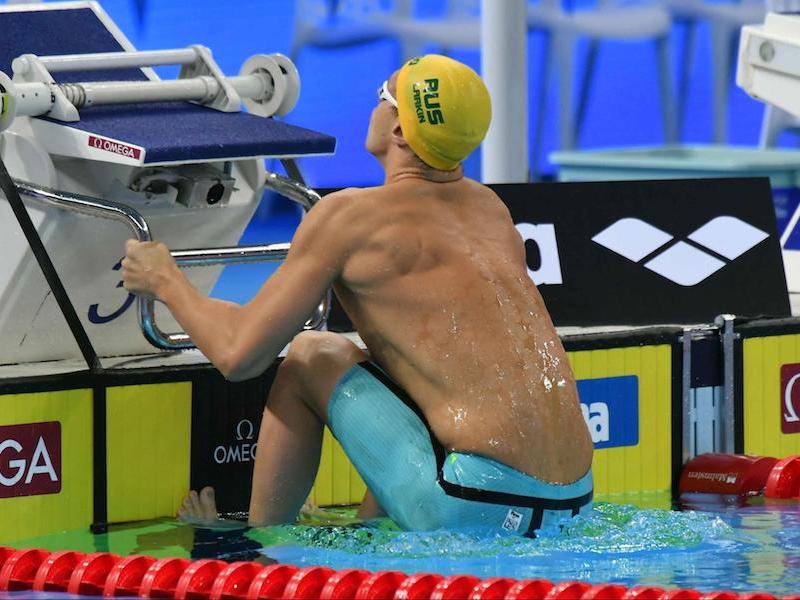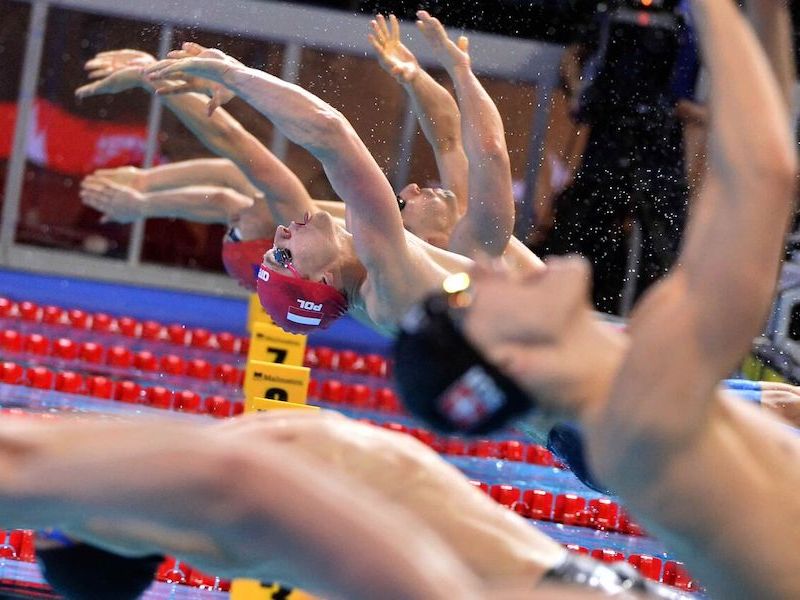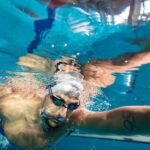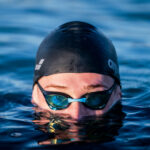Use These Backstroke Start Drills to Improve Your Form
The backstroke event involves one of the more difficult starts in the sport of swimming. It’s the only swim event where you begin in the water and perform a backward dive to kick off your race. While the backstroke start might seem challenging to master, you’ll be able to fine-tune your form with hard work and knowledge of proper starting mechanics.
In this article we’ll go over each element that makes up the entire backstroke start. We’ll cover your grip, foot placement, the ready position, and head positioning, then go over the dive and the underwater phase of your start. To finish up, we’ll provide you with a handful of backstroke start drills so you can begin practicing your form.
Get a Good Grip
Unlike in freestyle, butterfly, and breaststroke starts, you begin your backstroke starting position with your back facing the opposite end of the pool. You’ll want to make sure you have a secure grip on the bar located on the lower side of the starting block.
The grip you take depends on the style starting block you have access to and your personal preference. Some starting blocks have a U-shaped bar, while others have a horizontal bar with vertical ends. Others will only have a horizontal grip.
As for personal preference, you’ll come to understand what feels most comfortable for you as you begin running through your backstroke start drills. An excellent place to start is to grip the bar with your hands about shoulder-width apart. Take up a grip that feels firm and will allow you to pull up into the starting position with your feet planted against the wall.
Plant Your Feet
You can place your feet in a few positions. Foot placement depends on the type of pool you’re swimming in, whether you’re using a backstroke start wedge, and your personal preference.
In a 25-yard short course pool with gutters on the end walls, you can place your feet so that your toes curl over the edge of the gutter. For a pool without gutters, you can put your feet anywhere on the wall that feels comfortable for you. Some individuals prefer higher foot placement near the surface of the water, while others place their feet lower. Try to place your feet on the wall rather than on the slippery tiles that make up the cross.
Some competitions (like in NCAA and the Olympics) allow a starting wedge, which is an adjustable ledge that hangs from the starting block into the water. It provides the swimmer with an extra grip to avoid slipping at the start signal. The use of a wedge comes down to personal preference, and we recommend training with and without a wedge to see what you like more.
Whatever way you decide to place your feet, make sure you put them firmly against the wall or starting wedge, so you don’t slip when pushing off. Alter your foot placement while you train so you can find what works best for you. Try starting with your feet in line with one another and also try staggering them slightly. You can move them higher and lower on the wall until you find what you like.
Pull Up Into Ready Position

The next step for your start is to pull yourself up into the ready position. To do this, pull yourself up using the bars while keeping your feet firmly planted against the wall. Continue to raise yourself out of the water until your glutes are just under or at the surface of the water.
Bend your knees at about a 90-degree angle. Push your glutes outward away from the wall and bring your head slightly forward toward the block.
A study from the University of Western Ontario suggests backstrokers should work with their coaches to find the optimum knee angle for their starts. The study indicates that a larger knee angle results in an entry further from the wall, while a smaller angle results in a start with greater velocity.
When you find the correct position, your feet shouldn’t slip off the wall, and your weight should be distributed evenly.
Keep a Neutral Head Position
Head position is another matter of personal preference. Some swimmers start with their heads tilted back, and others tuck their chin close to their chest.
You can experiment with different head positions, but we recommend placing your head in a neutral position to start. The neutral head position will allow you to toss your head back at the start to optimize your dive into the water.
Perform an Excellent Dive
A good backstroke starting dive should result in a graceful entry into the water. Your hands should enter the water first, followed by your head, shoulders, hips, legs, and feet.
To achieve this, you’ll need to perform an explosive push off the wall. Start by pushing through your arms away from the block and immediately begin driving with your legs evenly through both feet. After driving through your legs, throw your head back and start arching your back at the height of your dive. Then, focus on your hands entering the water, followed by the rest of your body.
Streamline Into Your First Lap
During the underwater phase of your lap, you’ll want to use the underwater dolphin kick. You can flutter kick during the underwater phase if you’re just learning how to swim backstroke, but the dolphin kick will yield more power.
Make sure your body is in a streamlined position with your arms pressed tightly against the sides of your head. Begin dolphin kicking by bending at the hips and thrusting your legs in an up-and-down motion to propel yourself forward. You can use a kickboard to train your dolphin kick.
Next comes the swimming section of your race. It’s vital to train swimming backstroke drills in your workouts as well, but for the time being, let’s move on to the starting drills.
Backstroke Start Drills for You to Practice

Practice the backstroke start drills below to fine-tune your starting form. Remember to keep in mind the mechanics mentioned above while training at these drills.
Train in a Safe Environment and Prepare Your Body
First, you should make sure you’re training in a safe environment. Ensure the water is deep enough so you won’t come into contact with the bottom of the pool. Check your surroundings so that there are no swimmers around that you might land on while performing your backstroke start drills.
Before any training, you should consider a good warm-up and incorporate a stretching routine to improve mobility and enhance all aspects of your swimming, including starts.
Explosive Push-Off Drill (No Dive)
This drill will focus on developing your leg strength and coordination during your starts:
- Get in your ready position.
- Have your swim coach or another person signal your start.
- At the signal, drive through both of your legs evenly and with all your strength.
- Push straight up into the air and try to get your entire body out of the water.
- Do not arch your back.
- Enter the water with your glutes first.
Backstroke Start Drill Over a Pool Noodle
After you’ve developed leg strength and coordination, use this drill to get the hang of arching your back into the dive:
- Have someone hold a pool noodle over where you’ll dive.
- Get in your ready position.
- Push off the wall.
- Toss your head and arms backward and begin to arch your back.
- Dive over the pool noodle without touching it.
- Focus on entering the water, starting with your hands and with the rest of your body following.
Timed Backstroke Start Drill
Now it’s time to put your whole backstroke start together and time it so you can evaluate your improvement:
- Have someone standing at the 15-meter mark with a stopwatch.
- Have the same person give you a start signal and start the stopwatch.
- Perform your backstroke start.
- Dolphin kick during the underwater phase and focus on keeping an excellent streamlined body position.
- When your arms cross the 15-meter mark, have the person stop the watch.
- Repeat the backstroke start drill and tweak your form until you see improvements in your time.
Time to Dive Into Your Backstroke Start Drills
Now that you understand the mechanics that go into a good backstroke start, you can take your new knowledge to the pool. Focus on a good grip and comfortable, athletic foot positioning. Remember to drive through your legs into a dive that results in a clean entry into the water. Keep practicing at the backstroke start drills listed above to improve your form and speed!
Be sure you’re also geared up properly both in and out of the pool for all your practices. Check out arena’s training suits for men and women’s swimwear, plus towels and robes for after you put in all that hard work.
Written by:
Harrison Howarth
Harrison is a freelance writer with a background in competitive aquatic sports. His love for water polo and swim, combined with his passion for writing and education, drives him to continue teaching and inspiring individuals to participate in aquatics.







